Polychromy in Ancient Greek Sculpture: New Scientific Research on an Attic Funerary Stele at the Metropolitan Museum of Art
Abstract
:1. Introduction
2. Experimental
2.1. Multiband Imaging
2.2. Digital Microscopy
2.3. XRF
2.4. Raman Spectroscopy
2.5. SEM-EDS
2.6. μXRD
3. Results
3.1. The Polychromy Scheme
3.2. Minimally Invasive Analysis of Pigments
3.2.1. Blue Pigments
3.2.2. Red Pigments
3.2.3. Yellow Pigments
3.2.4. Black Pigments
3.2.5. White Pigments
4. Conclusions
Supplementary Materials
Author Contributions
Funding
Institutional Review Board Statement
Informed Consent Statement
Data Availability Statement
Acknowledgments
Conflicts of Interest
References
- Vlassopoulou, C. History of the research on polychromy in sculpture. In Archaic Colors; Acropolis Museum: Athens, Greece, 2012. [Google Scholar]
- Panagiotidou, D.; Merkouri, E.; Kokkinou, L. The use of color in Archaic sculpture. In Archaic Colors; Acropolis Museum: Athens, Greece, 2012. [Google Scholar]
- Gasanova, S.; Pagès-Camagna, S.; Andrioti, M.; Lemasson, Q.; Brunel, L.; Doublet, C.; Hermon, S. Polychromy analysis on Cypriot archaic statues by non- and micro-invasive analytical techniques. Archaeometry 2017, 3, 528–546. [Google Scholar] [CrossRef] [Green Version]
- Østergaard, J.S.; Schwartz, A. A Late Archaic/Early Classical Greek Relief with Two Hoplites (Ny Carlsberg Glyptotek IN 2787). Jahrb. Des Dtsch. Archäologischen Inst. 2022, 137, 1–37. [Google Scholar]
- Ike, K. The polychromy of the Parthenon: A reconstruction study on its meaning and system. J. Archit. Plann. Environ. Eng. AIJ 2000, 537, 265–273. [Google Scholar] [CrossRef] [PubMed] [Green Version]
- Aggelakopoulou, E.; Sotiropoulou, S.; Karagiannis, G. Architectural Polychromy on the Athenian Acropolis: An In Situ Non-Invasive Analytical Investigation of the Colour Remains. Heritage 2022, 5, 756–787. [Google Scholar] [CrossRef]
- Kefalidou, E. Late Archaic polychrome pottery from Aiani. Hesperia 2001, 70, 183–219. [Google Scholar] [CrossRef]
- Bourgeois, B.; Jeammet, V. The polychromy of Greek terracotta figurines: Material approach to a pictural culture. Rev. Archéol. 2020, 69, 3–28. [Google Scholar] [CrossRef]
- Bertram, H. Chapter Five: The Archaic and Classical Figurines. Mouseion 2021, 18, 134–162. [Google Scholar] [CrossRef]
- Kiilerich, B. Towards a ‘Polychrome History’ of Greek and Roman Sculpture. J. Art. Hist. 2016, 15, 1. [Google Scholar]
- Panzanelli, R.; Schmidt, E.D.; Lapatin, K. The Color of Life: Polychromy in Sculpture from Antiquity to the Present; Getty Publications: Los Angeles, CA, USA, 2008. [Google Scholar]
- Brinkmann, V.; Primavesi, O.; Hollein, M. Circumlitio. The Polychromy of Antique and Medieval Sculpture; Hirmer Publishers: Munich, Germany, 2010. [Google Scholar]
- Brinkmann, V.; Dreyfus, R. Gods in Color: Polychromy in the Ancient World; DelMonico/Prestel: Munich, Germany, 2017. [Google Scholar]
- Pandermalis, D. Archaic Colors; Argo Printing House: Athens, Greece, 2012. [Google Scholar]
- Gasanova, S.; Pagès-Camagna, S.; Andrioti, M.; Hermon, S. Non-destructive in situ analysis of polychromy on ancient Cypriot sculptures. Archaeol. Anthropol. Sci. 2018, 10, 83–95. [Google Scholar] [CrossRef]
- Karydas, A.G.; Brecoulaki, H.; Bourgeois, B.; Jockey, P.; Zarkadas, C. In-situ XRF Analysis of raw pigments and traces of polchromy on marble sculpture surfaces. Possibilities and limitations. In Proceedings of the 28th International Symposium on the Conservation and Restoration of Cultural Property: Non Destructive Examination of Cultural Objects-Recent Advances in X-ray Analysis, Tokyo, Japan, 1–3 December 2004. [Google Scholar]
- Blume, C. The role of the stone in the polychrome treatment of Hellenistic sculptures. In Proceedings of the IX ASMOSIA Conference: Interdisciplinary Studies on Ancient Stone, Tarragona, Spain, 8–13 June 2009. [Google Scholar]
- Abbe, M.B.; Borromeo, G.E.; Pike, S. A Hellenistic Greek marble statue with ancient polychromy reported to be from Knidos. In Proceedings of the IX ASMOSIA Conference: Interdisciplinary Studies on Ancient Stone, Tarragona, Spain, 8–13 June 2009. [Google Scholar]
- Campbell, L. Polychromy on the Antonine Wall Distance sculptures: Non-destructive Identification of pigments on Roman reliefs. Britannia 2020, 51, 175–201. [Google Scholar] [CrossRef]
- Verri, G.; Clementi, C.; Comelli, D.; Cather, S.; Piqué, F. Correction of Ultraviolet-Induced Fluorescence Spectra for the Examination of Polychromy. Appl. Spectrosc. 2008, 62, 1295–1302. [Google Scholar] [CrossRef] [PubMed]
- Stager, J.M.S. Seeing Color in Classical Art; Cambridge University Press: Cambridge, UK, 2022. [Google Scholar]
- Neri, E.; Alfeld, M.; Nasr, N.; de Viguerie, L.; Walter, P. Unveiling the paint stratigraphy and technique of Roman African polychrome statues. Archaeol. Anthropol. Sci. 2022, 14, 118. [Google Scholar] [CrossRef]
- Abbe, M. Polychromy. In The Oxford Handbook of Roman Sculpture; Friedland, E.A., Grunow Sobocinski, M., Gazda, E.K., Eds.; Oxford University Press: New York, NY, USA, 2015; pp. 173–188. [Google Scholar]
- Alfeld, M.; Mulliez, M.; Martinez, P.; Cain, K.; Jockey, P.; Walter, P. The Eye of the Medusa: XRF imaging reveals unknown traces of antique polychromy. Anal. Chem. 2017, 89, 1493–1500. [Google Scholar] [CrossRef] [PubMed]
- Brøns, C.; Stenger, J.; Bredal-Jørgensen, J.; Di Gianvincenzo, F.; Brandt, L.Ø. Palmyrene Polychromy: Investigations of Funerary Portraits from Palmyra in the Collections of the Ny Carlsberg Glyptotek, Copenhagen. Heritage 2022, 5, 1199–1239. [Google Scholar] [CrossRef]
- Odriozola, C.P.; Beltrán Fortes, J.; Loza Azuaga, M.L.; Martinez Blanes, J.M. Polychromy in Roman Portraits from Asido (Medina Sidonia, Cádiz, Spain). Livia, Germanicus and Drusus Minor. Herit. Sci. 2022, 10, 108. [Google Scholar] [CrossRef]
- Abramitis, D.H.; Basso, E.; Carò, F.; Hemingway, S.; Lepinski, S.; Leona, M. Ancient Greek Sculpture in Color. Perspective 2022. Available online: https://www.metmuseum.org/perspectives/articles/2022/8/new-research-greek-sphinx (accessed on 22 February 2023).
- Richter, G.M.A. An Archaic Greek Sphinx. Metropol. Mus. Art B 1940, 35, 178–180. [Google Scholar] [CrossRef]
- Richter, G.M.A.; Hall, L.F. Polychromy in Greek Sculpture. Metropol. Mus. Art B 1944, 2, 233–240. [Google Scholar] [CrossRef]
- Hemingway, S.; Lepinski, S.; Abramitis, D.H.; Basso, E.; Carò, F.; Leona, M. New Research on the Polychromy of an Archaic Grave Stele and Finial in the Form of a Sphinx in the Collection of The Metropolitan Museum of Art, New York. In Proceedings of the 10th International Round Table on Polychromy in Ancient Sculpture and Architecture: Color and Space. Interfaces of Ancient Architecture and Sculpture, Berlin, Germany, 10–13 November 2020. [Google Scholar]
- Solé, V.A.; Papillon, E.; Cotte, M.; Walter, P.; Susini, J. A multiplatform code for the analysis of energy dispersive X-ray fluorescence spectra. Spectrochim. Acta B 2007, 62, 63–68. [Google Scholar]
- McCormack, J. The darkening of cinnabar in sunlight. Miner. Depos. 2000, 35, 796–798. [Google Scholar] [CrossRef]
- Terrapon, V.; Béarat, H. A study of cinnabar blackening: New approach and treatment perspective. In Proceedings of the 7th International Conference on Science and Technology in Archaeology and Conservation at Petra, Petra, Jordan, 7–12 December 2010. [Google Scholar]
- Elert, K.; Pérez Mendoza, M.; Cardell, C. Direct evidence for metallic mercury causing photo-induced darkening of red cinnabar tempera paints. Commun. Chem. 2021, 4, 174. [Google Scholar] [CrossRef] [PubMed]
- Spring, M.; Grout, R. The Blackening of Vermilion: An Analytical Study of the Process in Paintings. NAACOG Tech. Bull. 2002, 23, 50–61. [Google Scholar]
- Keune, K.; Boon, J.J. Analytical imaging studies clarifying the process of the darkening of vermilion in paintings. Anal. Chem. 2005, 77, 4742–4750. [Google Scholar] [CrossRef]
- Nöller, R. Cinnabar reviewed: Characterization of the red pigment and its reactions. Stud. Conserv. 2015, 60, 79–87. [Google Scholar] [CrossRef]
- Kostomitsopoulou Marketou, A.; Kouzeli, K.; Facorellis, Y. Colourful earth: Iron-containing pigments from the Hellenistic pigment production site of the ancient agora of Kos (Greece). J. Archaeol. Sci. Rep. 2019, 26, 101843. [Google Scholar] [CrossRef]
- Sargent, M.L.; Spaabek, L.R.; Scharff, M.; Østergaard, J.S. Documentation and investigation of traces of colour on the Archaic Sphinx NCG IN 1203. In Tracking Colour. The Polychromy of Greek and Roman Sculpture in the Ny Carlsberg Glyptotek, Preliminary Report 1; Østergaard, J.S., Copenhagen Polychromy Network, Eds.; Ny Carlsberg Glyptotek: Copenhagen, Denmark, 2009; pp. 74–89. [Google Scholar]
- Brecoulaki, H. “Precious colours” in Ancient Greek polychromy and painting: Material aspects and symbolic values. Revue. Archéol. 2014, 1, 3–35. [Google Scholar] [CrossRef]
- Katsaros, T. Pigments–Composition and Origin. In Archaic Colors; Acropolis Museum: Athens, Greece, 2012; pp. 18–24. [Google Scholar]
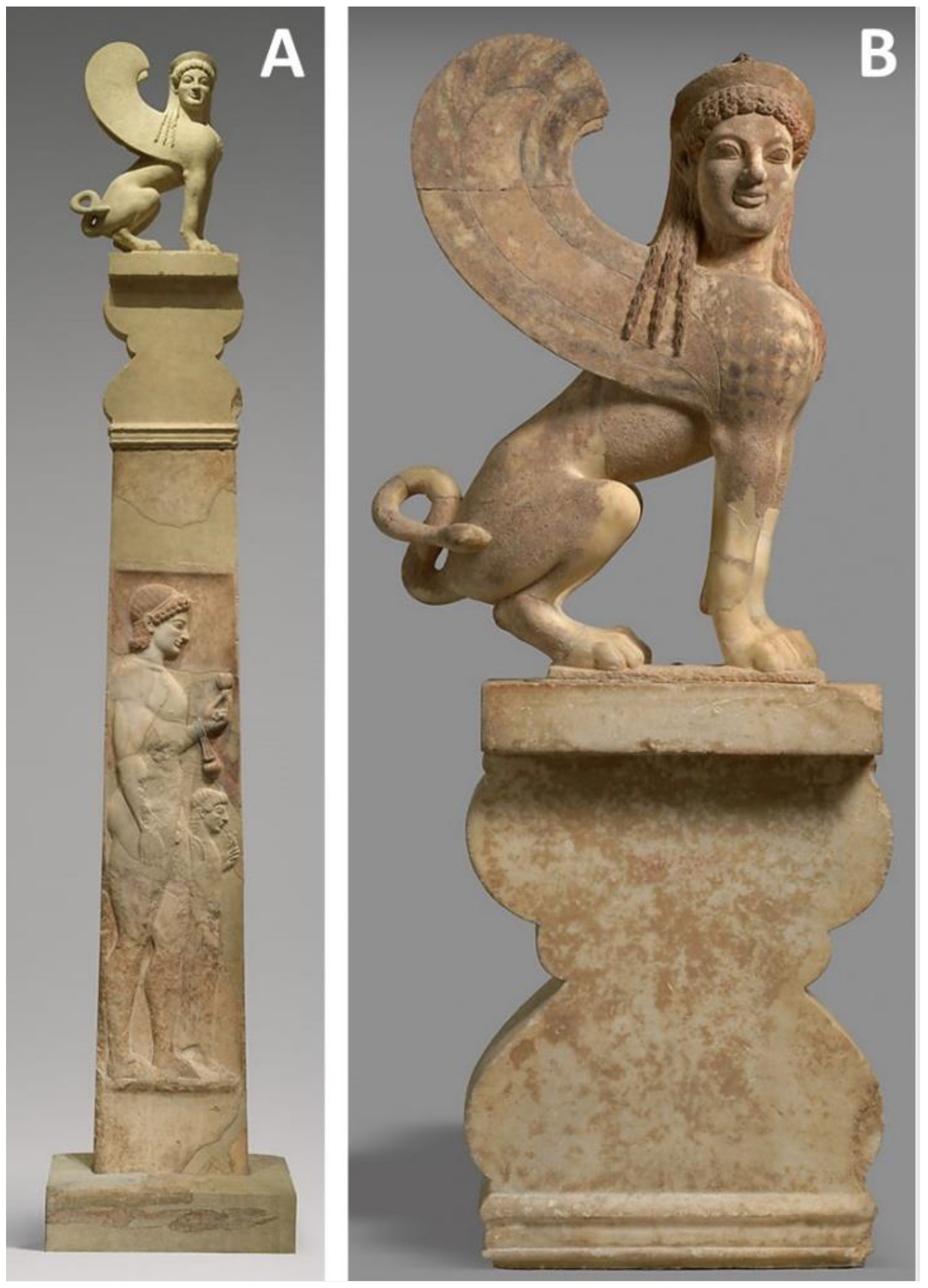





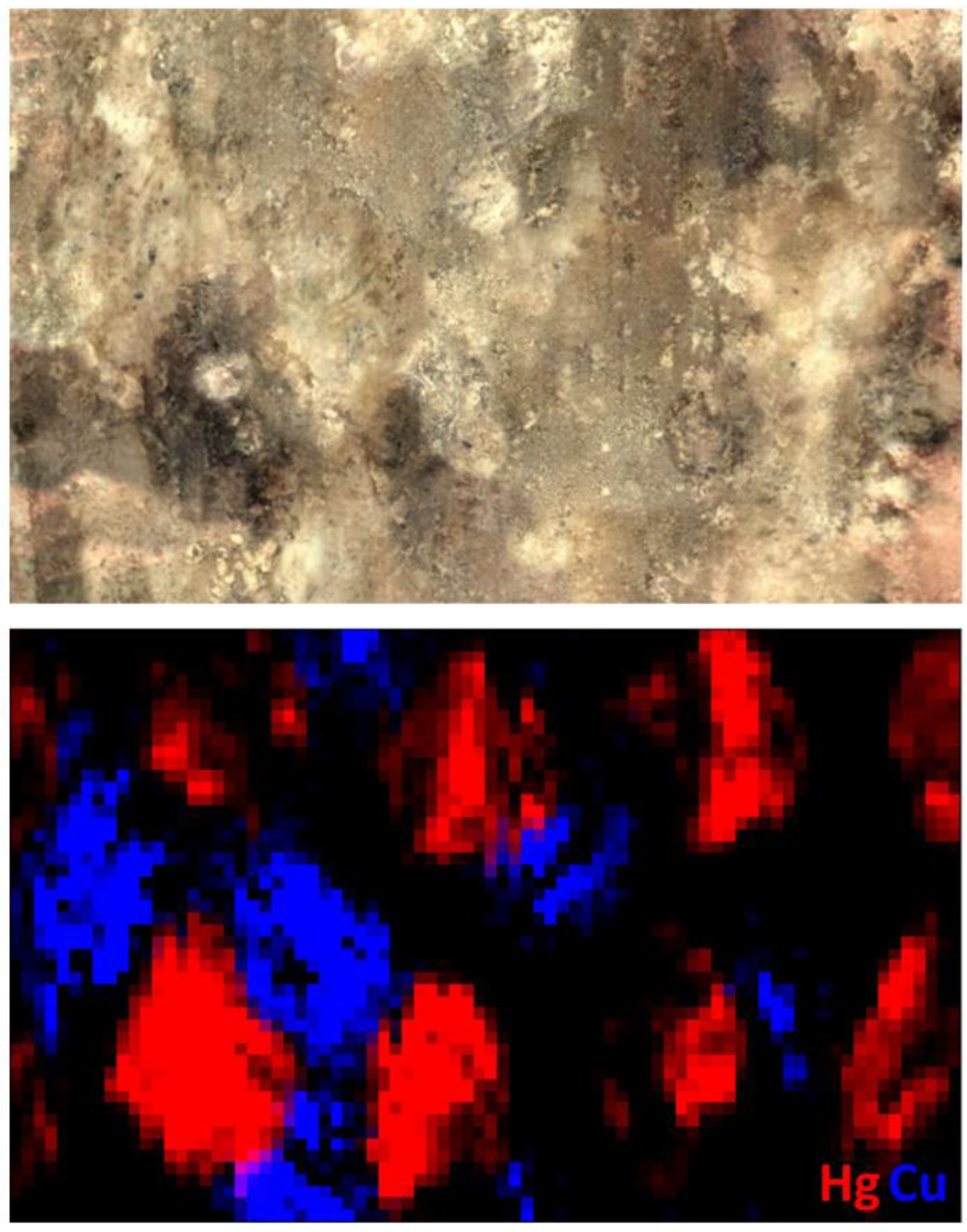
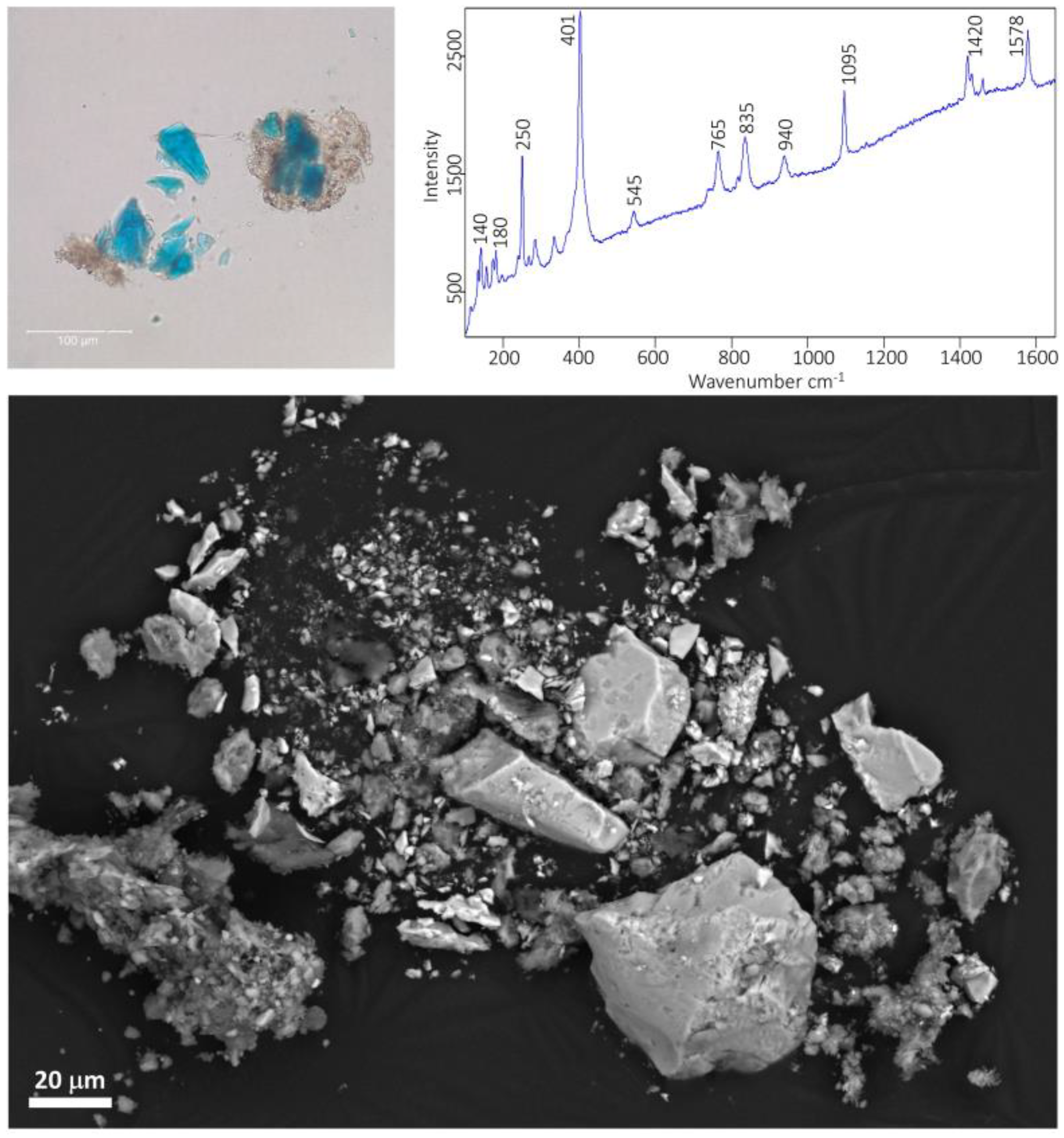
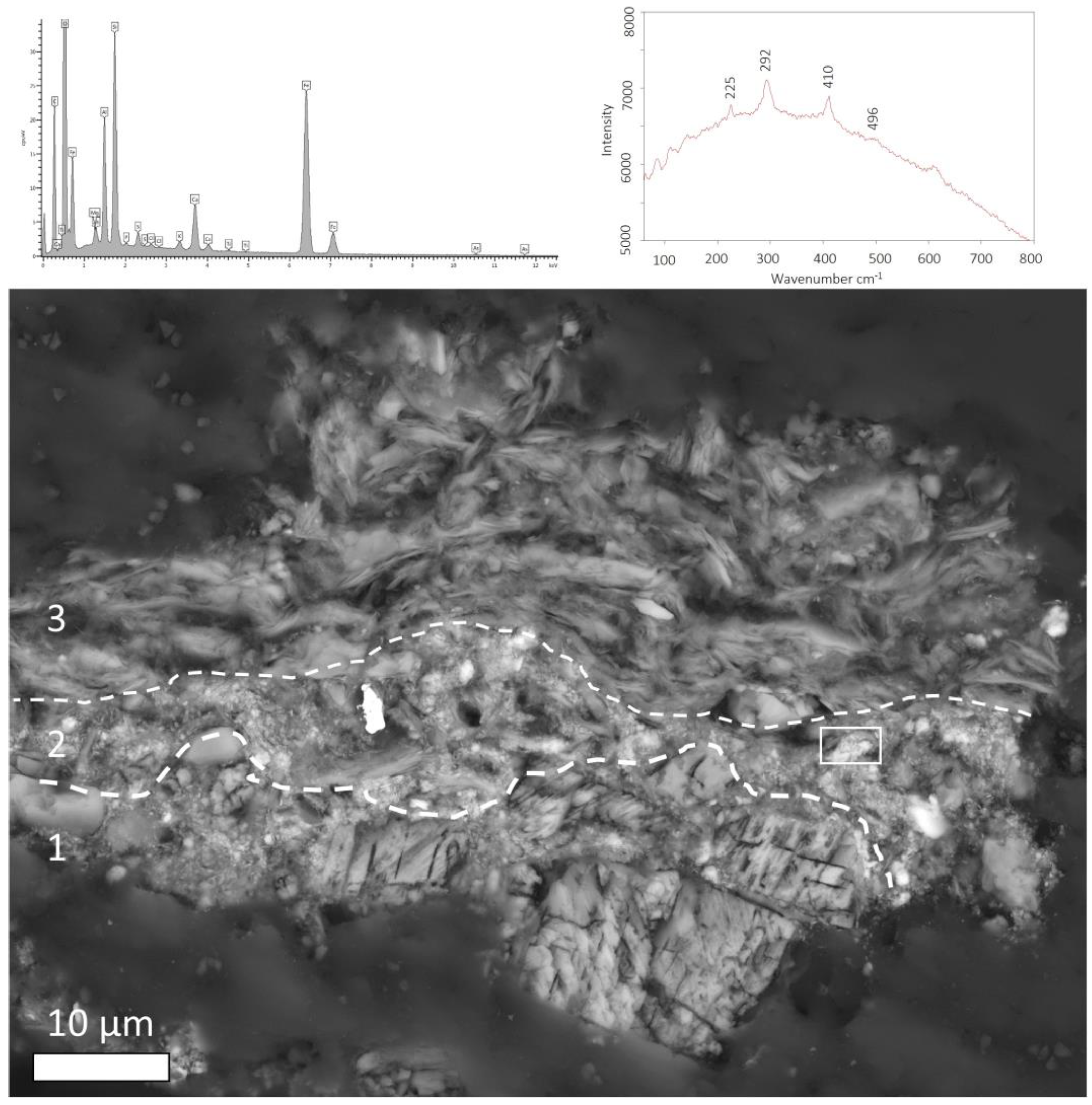
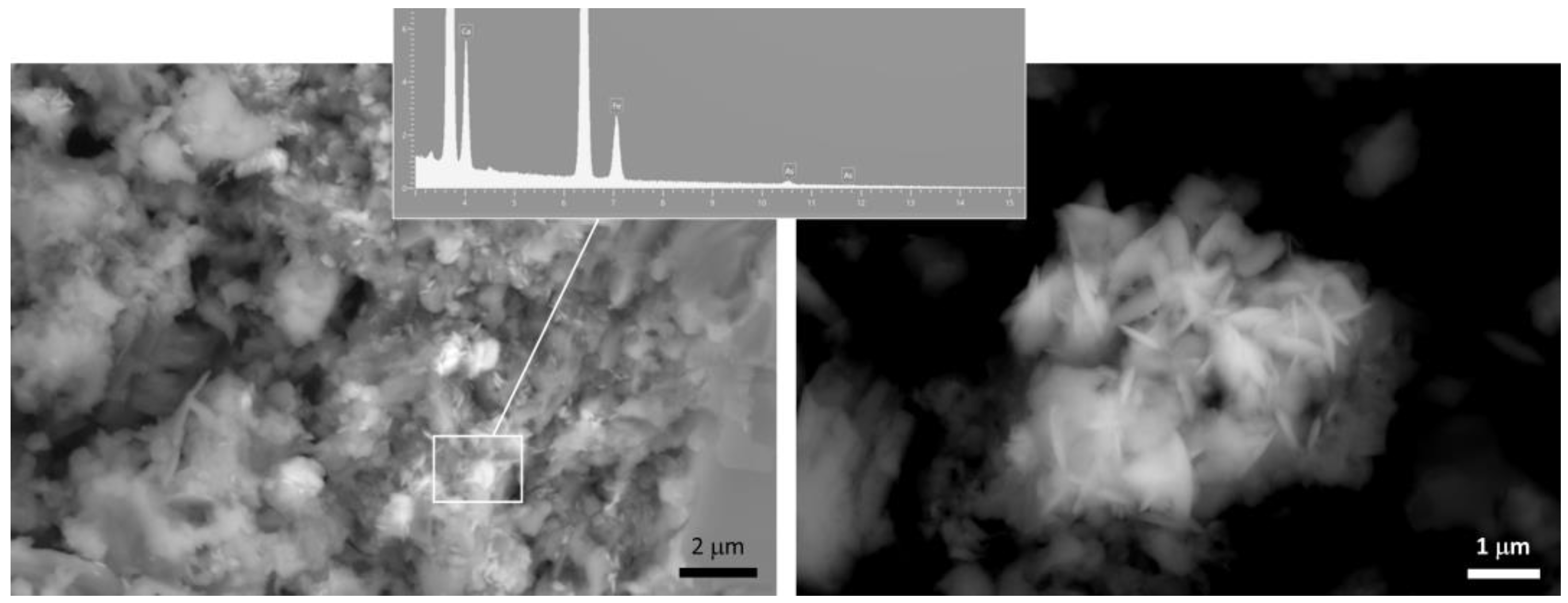
| Sample | Description | Color | Location |
|---|---|---|---|
| S1B | Loose particle | Blue | End of the tail |
| S2R | Loose particles | Red | Flight feather of the proper right wing |
| S3R | Loose particles | Brown/Red | Lioness skin, between wings |
| S4R | Cross section | Red | Sphinx’s hair |
| S5R | Loose particles | Brown/Red | Front left leg |
| S6Y | Loose particles | Yellow | Back of the diadem |
| S7Bl | Loose particles | Black | Flight feather outline of the proper right wing |
| S8Bl | Loose particles | Black | Genitals of the sphinx |
| S9W | Loose particles | White | Left eye of the sphinx |
| S10R | Cross section | Red | Sphinx’s hair |
Disclaimer/Publisher’s Note: The statements, opinions and data contained in all publications are solely those of the individual author(s) and contributor(s) and not of MDPI and/or the editor(s). MDPI and/or the editor(s) disclaim responsibility for any injury to people or property resulting from any ideas, methods, instructions or products referred to in the content. |
© 2023 by the authors. Licensee MDPI, Basel, Switzerland. This article is an open access article distributed under the terms and conditions of the Creative Commons Attribution (CC BY) license (https://creativecommons.org/licenses/by/4.0/).
Share and Cite
Basso, E.; Carò, F.; Abramitis, D.H. Polychromy in Ancient Greek Sculpture: New Scientific Research on an Attic Funerary Stele at the Metropolitan Museum of Art. Appl. Sci. 2023, 13, 3102. https://doi.org/10.3390/app13053102
Basso E, Carò F, Abramitis DH. Polychromy in Ancient Greek Sculpture: New Scientific Research on an Attic Funerary Stele at the Metropolitan Museum of Art. Applied Sciences. 2023; 13(5):3102. https://doi.org/10.3390/app13053102
Chicago/Turabian StyleBasso, Elena, Federico Carò, and Dorothy H. Abramitis. 2023. "Polychromy in Ancient Greek Sculpture: New Scientific Research on an Attic Funerary Stele at the Metropolitan Museum of Art" Applied Sciences 13, no. 5: 3102. https://doi.org/10.3390/app13053102
APA StyleBasso, E., Carò, F., & Abramitis, D. H. (2023). Polychromy in Ancient Greek Sculpture: New Scientific Research on an Attic Funerary Stele at the Metropolitan Museum of Art. Applied Sciences, 13(5), 3102. https://doi.org/10.3390/app13053102








